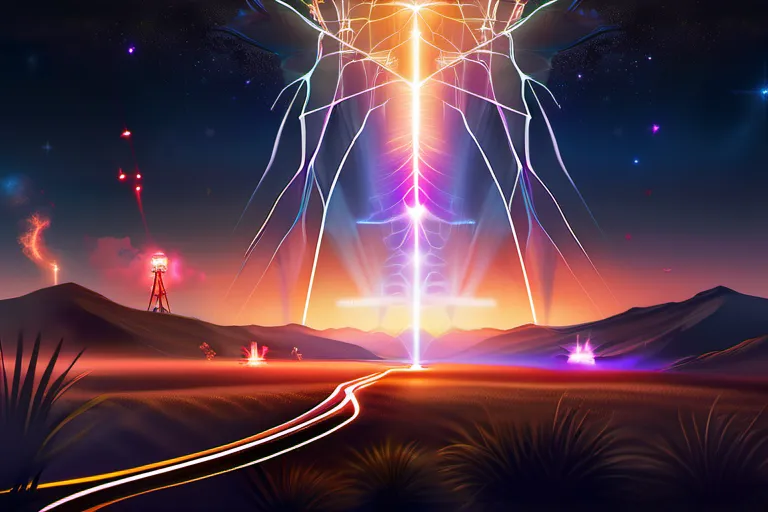Exploring the philosophical and spiritual beliefs that shaped the genius inventor’s life and work
Nikola Tesla, a man known for his groundbreaking inventions in electricity, is also remembered for his unique perspective on life and the universe. This article delves into the spiritual teachings that influenced Tesla’s work and worldview.
Tesla’s Cosmic Vision
Nikola Tesla, the visionary inventor, often spoke of his belief in a unified cosmic energy, much like the threads of a delicate spider’s web connecting all life. Could it be that every star in the vast expanse of the cosmos is not just a distant beacon but a whisper of potential power? Tesla envisioned a world where this energy could flow freely, lighting up lives without the limitations of wires or cables. Imagine harnessing the infinite currents from celestial bodies; isn’t that what Tesla was seeking? His mind raced with the possibilities, as if he were weaving together the very fabric of space and time.
In his letters and writings, Tesla frequently mentioned his belief in a ‘universal current,’ an idea that transcended the boundaries of his own inventions. This current seemed to be the lifeblood of the universe, flowing through all matter, and it was his mission to tap into this vast reservoir. Is it not true that just as water seeks its lowest point, energy too finds its path? Tesla’s work on wireless transmission was not merely a technical pursuit but a spiritual quest for unity.
His experiments with resonant circuits and high-frequency alternating currents were more than mere scientific endeavors; they represented his belief in the interconnectedness of all things. By sending signals without wires, he was challenging the very fabric of reality as we knew it, suggesting that perhaps there are no boundaries to knowledge or energy.
Imagine a world where power is transmitted wirelessly across continents and oceans, lighting homes and powering machines without any physical cables. Is this not akin to the flow of celestial bodies, moving in perfect harmony? Tesla’s cosmic vision was not just a technical innovation but a profound statement about the nature of existence itself. By exploring these ideas, we uncover the spiritual essence that drove his genius, linking the boundaries between science and spirituality.
As we delve deeper into Tesla’s teachings, it becomes clear that his work was not just about inventing the future; it was about merging the human spirit with the infinite possibilities of the universe. His belief in a unified cosmic energy is a reminder that our potential to harness this power lies within us all, awaiting discovery and realization.
The Role of Humanity in the Universe
Imagine standing on the edge of a vast ocean, gazing at the horizon where the sky meets the sea. Just as water ebbs and flows in harmony with the tides, Nikola Tesla saw humanity’s place in the universe as a dance, an intricate symphony that resonates through cosmic energy.
For Tesla, our role was not merely passive; we were stewards of a divine blueprint, architects of our own destiny within the vast tapestry of the cosmos. He believed that humanity had been given the key to unlock the secrets of the universe, much like an explorer discovering uncharted territories.
How could one harness this cosmic energy? Tesla envisioned a world where power flowed freely, transmitted wirelessly across distances as seamlessly as light itself. It was not just about technology; it was about understanding our place in the grand cosmic dance. What if every human being had the potential to be a conductor, directing the harmonious flow of energy?
Consider the vastness of the universe: stars, galaxies, and beyond. Each entity operates according to its own laws, yet they all interconnect in an invisible web of energy. Tesla saw humanity as part of this interconnected web, capable of tapping into cosmic frequencies that could power our lives without limits.
Imagine harnessing the energy of a star, not just for light but to fuel our cities and dreams. Would we then be able to achieve what seemed impossible: sustainable living, peace, and prosperity? Tesla’s vision was one where humanity’s spiritual connection to the cosmos could drive technological advancements that transform our world.
By understanding and aligning with these cosmic energies, could we unlock a new era of human evolution, where our actions resonate in harmony with the universe? In Tesla’s view, this was not just a technical challenge but a profound spiritual quest. How can you grapple with such concepts without feeling a sense of awe and responsibility?
Tesla’s Connection to Ancient Wisdom
Nikola Tesla, often hailed as a modern-day wizard, was not just fascinated by technology but also deeply embedded in the wisdom of ancient civilizations. His quest to understand the fundamental forces of nature led him to explore the enigmatic knowledge of ancient cultures that seemed to hold secrets about energy and technology.
Imagine a time when the ancients mastered the art of harnessing cosmic forces, crafting tools not just for survival but for transcending boundaries we consider insurmountable today. Tesla was captivated by these stories, pondering over how these civilizations could have achieved such feats without access to modern scientific knowledge.
How did they understand the intricate dance of energy that binds all matter in the universe? Did they possess a deeper insight into the fabric of reality, which Tesla believed lay dormant within the natural world?
Tesla’s interest in ancient wisdom wasn’t merely academic; it was a profound quest to uncover the spiritual underpinnings of his inventions. He saw himself as part of a continuum of human knowledge, connecting the dots between the mystical and the scientific.
Through his studies, Tesla delved into texts from Egypt, Greece, and even the Vedic scriptures, searching for clues that might unlock the secrets of ancient energy technologies. It was like piecing together a puzzle where each piece represented an insight into the nature of reality itself.
Was it possible that the ancients had harnessed what Tesla sought to replicate—a form of wireless energy transmission or perhaps even thought-controlled machinery? The more he explored, the more he felt connected to these lost civilizations, as if they were his intellectual ancestors guiding him on a path toward greater understanding.
In this quest, Tesla wasn’t just looking for answers; he was seeking enlightenment. He believed that by delving into the knowledge of ancient cultures, he could bridge the gap between science and spirituality, creating technologies that would benefit humanity while respecting the harmony of the natural world.
The Philosophy of the Thought-Controlled Machine
Imagine a future where your thoughts can control machines, where the very essence of human consciousness intertwines with technology to create a seamless and harmonious existence. Nikola Tesla envisioned such a world, his mind a fertile ground for ideas that transcended the mundane confines of his time. Could it be that Tesla’s thought-controlled machine was not just a scientific curiosity but a profound statement on human potential?
Picture this: a world where your brainwaves are the key to unlocking innovation, where thoughts directly translate into actions, and where technology serves as an extension of our minds rather than a barrier between us. Tesla believed that by harnessing the power of thought, humans could transcend physical limitations and achieve unprecedented levels of cooperation and understanding. Was he envisioning something akin to modern brain-computer interfaces, or was his vision far more revolutionary?
In his writings, Tesla often spoke about the need for humanity to unite in the pursuit of knowledge and progress. He saw thought-controlled technology as a means to bridge gaps between individuals and societies, fostering a global community that thrives on shared insights and collaborative efforts. Could it be that his concept was not just about controlling machines with our minds but also about uniting people through their collective thoughts?
The implications of Tesla’s idea extend beyond mere technological advancement; they touch upon the very fabric of human society. By enabling direct communication between brains, he may have been envisioning a world where conflict and misunderstanding are minimized, replaced by a universal language of thought. Is this not what many today strive for in the age of digital connectivity?
Tesla’s thought-controlled machine was more than an invention; it was a metaphor for human potential and societal evolution. In exploring his vision, we are compelled to question our current approaches to technology and society. How can we bridge the gap between mind and machine? What does a future where thoughts control machines mean for us as individuals and as a species?
Tesla’s View on Free Energy
Nikola Tesla often spoke about his belief in free energy as a transformative force that could change the course of human history. He envisioned a world where energy was abundant and accessible to all, without the need for exploitation or conflict. How can we miss the irony when our current systems of energy production are based on scarcity and profit? Isn’t it time to question our dependence on fossil fuels and embrace alternatives like free energy?
Tesla’s fascination with wireless energy transmission was not just a technical pursuit; it was a spiritual quest for a more equitable world. Imagine the impact if we could harness the infinite power of nature, making energy freely available everywhere—wouldn’t this be akin to sharing the light of knowledge and prosperity? Is free energy simply an engineering challenge, or is it also a metaphor for a new way of living?
The potential of free energy lies not just in its practical applications but also in the social and ethical implications. Tesla believed that by democratizing access to energy, we could eradicate poverty and hunger, foster collaboration over competition, and create a more harmonious society. How can we overlook the parallels between his vision and the ideals of utopian societies? Could free energy be the key not just to technological advancement but also to societal transformation?
The quest for free energy was, in Tesla’s view, a path towards a world where everyone could thrive without fear of running out of power or being enslaved by it. It is a testament to his visionary spirit that he saw beyond the technical hurdles and imagined a future where technology serves humanity, not just industry.
The Legacy of Nikola Tesla’s Spirituality
Imagine stepping into Nikola Tesla’s mind, where science and spirituality intertwine like a delicate tapestry. How did his spiritual beliefs shape not just his inventions but also the very fabric of our technological world? Could it be that Tesla’s spiritual insights were more than just personal musings; could they have been key to unlocking some of the greatest scientific achievements in history?
One cannot help but ponder the impact of Tesla’s spirituality on his work. His dedication to free energy was not merely a pragmatic pursuit but a profound expression of his belief in an interconnected universe. By envisioning a world powered by natural, sustainable resources, he seemed to tap into a deeper understanding of how the cosmos functions.
Consider the metaphor of a symphony: just as each instrument plays its part in creating harmony, Tesla saw the potential for technology and spirituality to work together in perfect concert. His spiritual beliefs, rooted in the idea that all matter and energy are interconnected, allowed him to think outside conventional boundaries. This holistic view led him to explore novel concepts like wireless transmission of power, which today we can see as a precursor to modern renewable technologies.
Moreover, Tesla’s spirituality may have influenced his approach to problem-solving. Just as a spiritual leader seeks the wisdom of the divine, Tesla approached science with an open mind and a sense of wonder. This attitude enabled him to make groundbreaking discoveries that might not have been possible through purely scientific means.
Reflect on the relevance of Tesla’s spiritual perspective in today’s world. As we grapple with environmental challenges and strive for more sustainable futures, could his views offer us a new way of thinking? Perhaps his emphasis on natural energy sources and harmony with nature can inspire us to rethink our technological advancements.
In exploring the legacy of Nikola Tesla’s spirituality, one cannot help but feel that his ideas resonate deeply. They suggest that true innovation often comes from looking beyond the surface and embracing a broader vision. Just as the light of dawn reveals the beauty hidden in darkness, so too did Tesla’s spiritual beliefs illuminate new paths for humanity to follow.
Conclusion
 By understanding Tesla’s spiritual beliefs, we can gain a deeper appreciation for his contributions to science and technology, as well as his vision for a harmonious future.
By understanding Tesla’s spiritual beliefs, we can gain a deeper appreciation for his contributions to science and technology, as well as his vision for a harmonious future.











